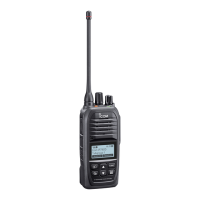4
USING THE IDAS MODE
4-3
Basic operation (Continued)
D Selecting a Zone
Certain channels are grouped together and assigned
to a Zone according to their intended use�
For example, Analog channels ‘Station 1’ and ‘Station
2’ are assigned to an “Analog” Zone, and Digital
channels ‘Station 3’ and ‘Station 4’ are assigned to a
“Digital” Zone�
L Conrm the that the function to enter the Zone
Selection screen is assigned to [Sub PTT], [Side 1],
or [Side 2]� You can assign functions in the Detailed
Set mode� See page 6-5 for details�
1� Push or hold down the key that is assigned for
entering the Zone Selection screen�
2� Rotate Rotary Selector or push [▲] or [▼] select a
zone�
3� Push [Call History] to exit the Zone Selection
screen and return to the Standby Screen�
D Receiving and transmitting
Receiving:
1� Rotate Rotary selector, or push [▲] or [▼] to
select a channel�
• When a Call is received, the Status indicator lights
green�
Transmitting:
CAUTION: DO NOT transmit without an antenna�
1� Wait until the channel is clear to avoid
interference�
2� While holding down [PTT], speak at your normal
voice level�
3� Release [PTT] to receive�
IMPORTANT:
To maximize the readability of your signal:
1� After pushing [PTT], pause briefly before you
start speaking�
2� Hold the microphone 5 to 10 cm (2 to 4 inches)
from your mouth, then speak at your normal
voice level�
NOTE: You can only transmit at low power in the
IDAS mode when using an optional BP-305 battery
case and alkaline batteries�
D Transmitting Notes
Transmit inhibit function
The transceiver has several inhibit functions which
restrict transmission under the following conditions:
Lockout function:
The function inhibits transmission when the channel
is busy� However, depending on a presetting, you can
transmit when a call is received that includes a non-
matching (or matching) CTCSS (DTCS), RAN (Radio
Access Number), Individual ID, or Group ID�
Time-Out Timer:
If continuous transmission exceeds the preset Time-
Out Timer time, the transmission is cut o. Release
[PTT], and then hold down again to resume talking�
Penalty timer:
After the transmission is cut o by the Time-Out Timer,
transmission is further inhibited for a preset penalty
period of time�

